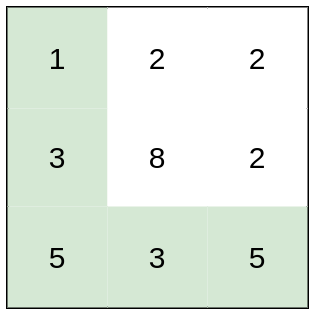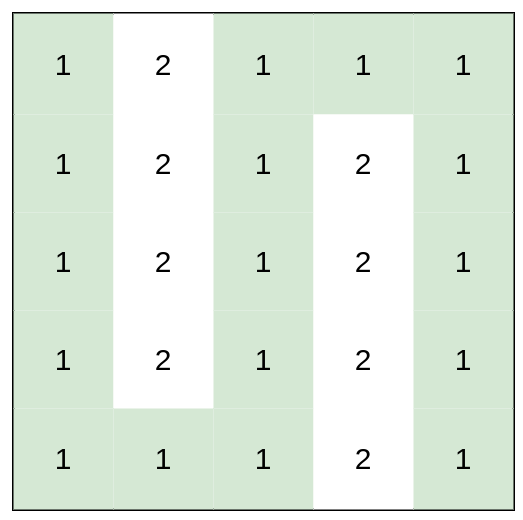
g1601_1700.s1631_path_with_minimum_effort.Solution Maven / Gradle / Ivy
package g1601_1700.s1631_path_with_minimum_effort;
// #Medium #Array #Depth_First_Search #Breadth_First_Search #Binary_Search #Matrix
// #Heap_Priority_Queue #Union_Find #2022_04_19_Time_75_ms_(60.52%)_Space_42.8_MB_(86.40%)
import java.util.PriorityQueue;
/**
* 1631 - Path With Minimum Effort\.
*
* Medium
*
* You are a hiker preparing for an upcoming hike. You are given `heights`, a 2D array of size `rows x columns`, where `heights[row][col]` represents the height of cell `(row, col)`. You are situated in the top-left cell, `(0, 0)`, and you hope to travel to the bottom-right cell, `(rows-1, columns-1)` (i.e., **0-indexed** ). You can move **up** , **down** , **left** , or **right** , and you wish to find a route that requires the minimum **effort**.
*
* A route's **effort** is the **maximum absolute difference** in heights between two consecutive cells of the route.
*
* Return _the minimum **effort** required to travel from the top-left cell to the bottom-right cell._
*
* **Example 1:**
*
* 
*
* **Input:** heights = \[\[1,2,2],[3,8,2],[5,3,5]]
*
* **Output:** 2
*
* **Explanation:** The route of [1,3,5,3,5] has a maximum absolute difference of 2 in consecutive cells. This is better than the route of [1,2,2,2,5], where the maximum absolute difference is 3.
*
* **Example 2:**
*
* 
*
* **Input:** heights = \[\[1,2,3],[3,8,4],[5,3,5]]
*
* **Output:** 1
*
* **Explanation:** The route of [1,2,3,4,5] has a maximum absolute difference of 1 in consecutive cells, which is better than route [1,3,5,3,5].
*
* **Example 3:**
*
* 
*
* **Input:** heights = \[\[1,2,1,1,1],[1,2,1,2,1],[1,2,1,2,1],[1,2,1,2,1],[1,1,1,2,1]]
*
* **Output:** 0
*
* **Explanation:** This route does not require any effort.
*
* **Constraints:**
*
* * `rows == heights.length`
* * `columns == heights[i].length`
* * `1 <= rows, columns <= 100`
* * 1 <= heights[i][j] <= 106
**/
@SuppressWarnings("java:S1210")
public class Solution {
private static class Pair implements Comparable {
int row;
int col;
int diff;
Pair(int row, int col, int diff) {
this.row = row;
this.col = col;
this.diff = diff;
}
public int compareTo(Pair o) {
return this.diff - o.diff;
}
}
public int minimumEffortPath(int[][] heights) {
int n = heights.length;
int m = heights[0].length;
PriorityQueue pq = new PriorityQueue<>();
pq.add(new Pair(0, 0, 0));
boolean[][] vis = new boolean[n][m];
int[] dx = {-1, 0, 1, 0};
int[] dy = {0, 1, 0, -1};
int min = Integer.MAX_VALUE;
while (!pq.isEmpty()) {
Pair p = pq.remove();
int row = p.row;
int col = p.col;
int diff = p.diff;
if (vis[row][col]) {
continue;
}
vis[row][col] = true;
if (row == n - 1 && col == m - 1) {
min = Math.min(min, diff);
}
for (int i = 0; i < 4; i++) {
int r = row + dx[i];
int c = col + dy[i];
if (r < 0 || c < 0 || r >= n || c >= m || vis[r][c]) {
continue;
}
pq.add(new Pair(r, c, Math.max(diff, Math.abs(heights[r][c] - heights[row][col]))));
}
}
return min;
}
}
© 2015 - 2025 Weber Informatics LLC | Privacy Policy